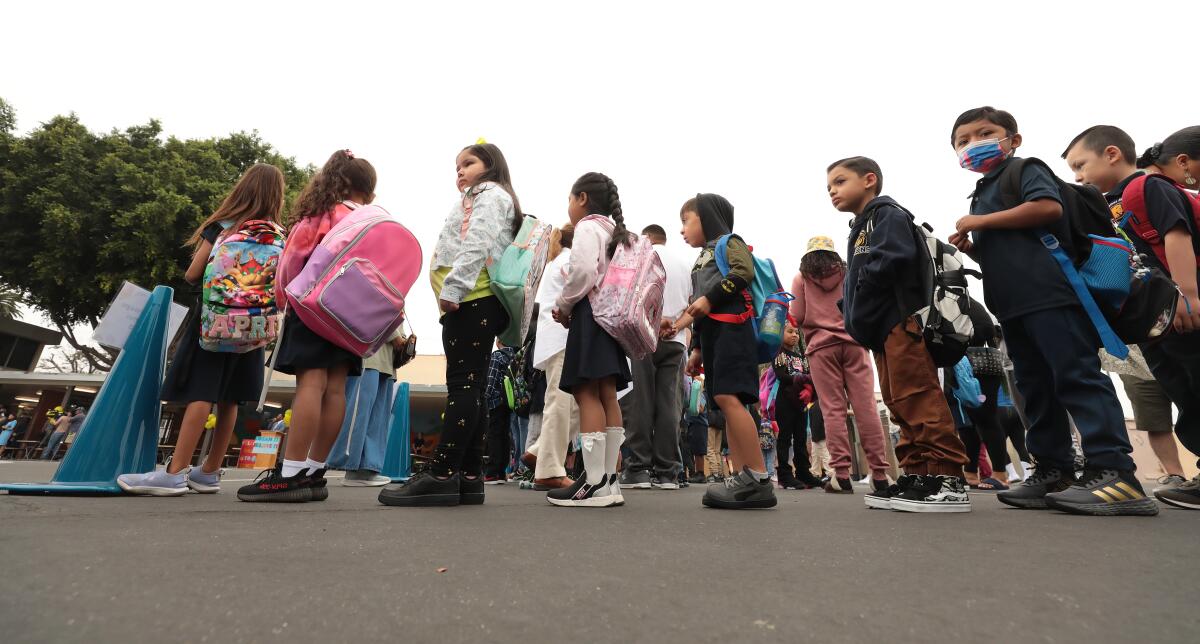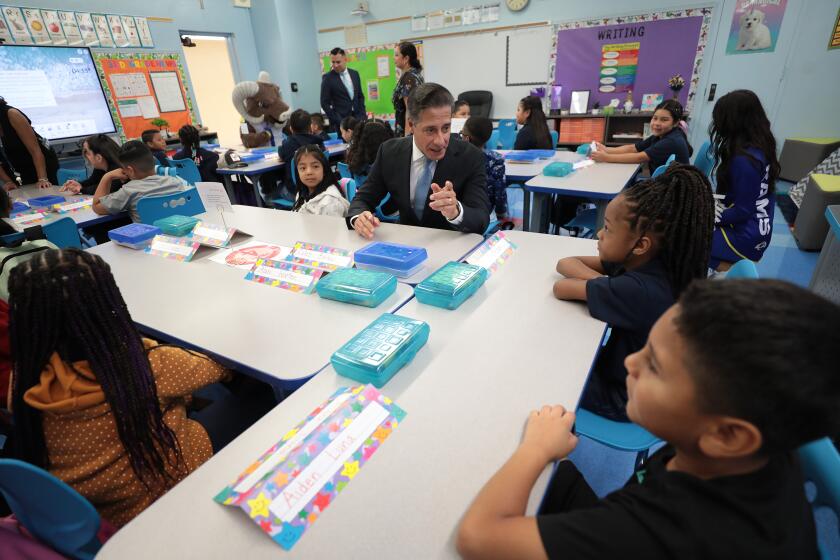Most California students fall short of grade-level standards in math and reading, scores show

- Share via
Most California students continue to struggle from pandemic learning setbacks and do not meet grade-level standards in math and reading, new state test scores show, with incremental gains in math but largely flat or slightly declining results in English.
While education officials could find data points that gave them hope, scores are at levels comparable to when the current testing system began in 2015 as school districts were still figuring out how to prepare for the annual examinations, given in grades 3 through 8 and grade 11.
Overall, student scores declined slightly in reading — less than one percentage point — with 46.7% achieving state learning standards for their grade, compared with 47.1% the year before. This means more than half of students did not meet grade-level benchmarks when they were tested in spring 2023.
In math, there was a modest gain of just over one percentage point, with 34.6% achieving state standards, compared with 33.4% a year earlier, in spring 2022. Even with the increase, about two-thirds of California students are not testing at grade level in math.
L.A. Unified — the state’s largest school system — improved a little more than the state as a whole in math — 2 percentage points — but it also started out lower and remains lower. The school system also started out lower in reading and fell back slightly more than the state as a whole.
State officials reported another sobering data point: a higher percentage of students from families facing “socioeconomic disadvantages,” which includes challenges such as poverty, low family education levels, homelessness and foster care experience. The percentage among California’s 5.9 million public school students rose from 60% to 63%.
L.A. Unified shows incremental progress in math scores, although scores remain low. English scores drop overall.
The Department of Education noted that test scores are typically worse for such students and added that remaining close to level on scores could be seen as progress when more families are struggling.
“California’s statewide scores are particularly promising as the proportion of high-need students has also increased in California schools,” the state said in its news release. “Specifically, the proportion of students tested who are socioeconomically disadvantaged increased.”
Stanford University professor Thomas S. Dee found much reason for concern.
“The state’s claim that ‘recovery is underway’ overstates the optimism these data justify,” said Dee, an expert in education and economic data. Even the modest improvement in math “represents less than 20% of the comparable achievement loss” since the 2018-19 school year.
Morgan Polikoff, associate professor of education at USC’s Rossier School of Education, said he was struck by the scarcity of pre-pandemic data in the state’s announcement: “You can’t read that press release and not notice that there is no comparison at all to pre-COVID” scores.
Despite resources and some evidence of progress, “our educational performance is not good,” Polikoff said. “And people don’t like to hear this.”
The state also released data on chronic absenteeism — defined as a student missing at least 10%, which is generally 18 days, of their school year. The figures for the last school year improved significantly over the prior year, but absence rates remained high by most reckonings: Nearly 25% were chronically absent in 2022-23 compared with 30% of students in 2021-22. The rate in kindergarten was considerably worse for both years.
Overall, students in public schools missed 15 days on average out of a 180-day school year.
COVID-19 was responsible for many absences. Last year, nearly 55% of absences were excused; some of them related to quarantines were required.
The ongoing absenteeism underscores the complexity of turning things around, said Reyna G. García-Ramos, professor of education at Pepperdine’s Graduate School of Education and Psychology. Another issue is the shortage of experienced teachers and, for all teachers, what their emphasis should be in the classroom.
Coming out of COVID, “we were making sure that our students were feeling a sense of belonging in school — with a lot of focus on social emotional learning. We also need to balance that with how we get at the content,” García-Ramos said.
A searchable state website provides scores for California, school districts, schools and groups of students.
State Board of Education President Linda Darling-Hammond found enough positivity in the new data to conclude that the state was “beginning to turn the corner on pandemic recovery.” There also were increases in the more recently created state science tests, although these scores remained low — at about the level of the math scores.
State Supt. of Public Instruction Tony Thurmond, a candidate for governor, did not provide a comment in his department’s news release and was not available Wednesday for comment.
In L.A. Unified, in math, 30.5% of all students are meeting or exceeding learning goals. Achievement gaps continue to be a problem. Although math scores for Black students improved, only 19% met the learning standards. About 7% of district students are Black. Latinos make up about 3 in 4 students; about 24% met math earning standards.
Disparities between Latino and Black students when compared with white and Asian students “continue to be disappointing yet unsurprising,” said Dalia Velasco, assistant manager of policy and advocacy at Alliance for a Better Community, a local advocacy group. These students have “inequitable access to learning opportunities,” including through “high-quality and affordable internet. ... The COVID-19 pandemic has only magnified the preexisting issues.”
L.A. schools Supt. Alberto Carvalho said he is pleased that the percentage of students who met learning standards in math rose at all grade levels that take part in the state tests.
“We are making progress, particularly in mathematics,” Carvalho said. “We put a lot of resources and efforts in mathematics.”
Supporters say proposed state K-12 framework will make higher-level math accessible to more. Critics contend it will make poor math outcomes worse.
Darling-Hammond said that in general, math scores have been more volatile during and after the pandemic. It was simply harder for students to learn math when campuses were closed during the worst of the pandemic, she said.
“Traditionally, math scores are more responsive to school factors than English language arts scores, because kids don’t tend to use math outside of school,” Darling-Hammond said. “When we were in the pandemic years, math scores dropped further” than English scores.
Conversely, she added, it would make sense that math scores would show more of a rebound: “So that piece makes sense.”
Even with the improvement, L.A. Unified math scores still were below levels from the 2017-18 school year, two years before the pandemic resulted in campus closures.
The same holds for English scores, which were slightly down overall compared with last year, with 41.2% of students meeting standards. Among all district students, scores dropped by half a percentage point.
District officials called attention to incremental gains for reading scores in grades 3, 4 and 11. In an interview, Carvalho said the 11th-grade scores seemed like an anomaly — welcome news, but difficult to explain and perhaps not meaningful in the big picture.
UC Berkeley education professor Frank C. Worrell was unimpressed by any of the L.A. Unified scores, calling them “appalling.”
More broadly, “these scores speak to our ongoing inability as a state to provide a quality education to children and adolescents generally, and even more so with regard to English learners, students with disabilities and children of color,” Worrell said.
The relative progress in grades 3 and 4 could represent the success of one-on-one and small-group instruction that focused especially on the early grades.
L.A. Unified Supt. Alberto Carvalho said the program that will replace the lauded Primary Promise is more equitable and effective, while costing far less.
Some parents and teachers will see the results for younger students as vindicating their defense of Primary Promise, an intensive and high-cost reading and math program that focused on the early elementary grades. Two former school district superintendents had stepped forward to defend the program when Carvalho made it clear he would go in a different direction.
Carvalho did not deny that Primary Promise had benefits, but said the overall results justify his decision to redistribute resources to also reach more older students. They too need added support, he said.
More limited support for older students could have been a factor in the declining scores of these students, Carvalho said.
Regarding those declining scores, “I attribute that 100% to two factors: still the lingering effects of the pandemic, the learning loss. Secondly, the fact that the district had a reading strategy that was focused in such a narrow bandwidth,” Carvalho said in an interview.
He added that he also was concerned that the benefits from Primary Promise would fade over time without ongoing intervention support for older students.
Carvalho did not back down from his earlier pledge to recover from the pandemic in two years, promising “explosive” growth in reading test scores.
In a presentation during Tuesday’s school board meeting, L.A. school officials outlined various ways in which students are being helped, including teacher training and improved instructional materials and student assessments.
School districts across California have received billions of dollars to address pandemic learning setbacks — with uncertain benefits.
The L.A. school board in June approved an $18.8-billion budget that included the last major tranche of pandemic aid — which will disappear in future years.
Darling-Hammond said the benefits from such aid have been reaching students gradually over the last couple of years, and she is hopeful that student achievement will soon show strong results from it.
More to Read
Sign up for Essential California
The most important California stories and recommendations in your inbox every morning.
You may occasionally receive promotional content from the Los Angeles Times.














